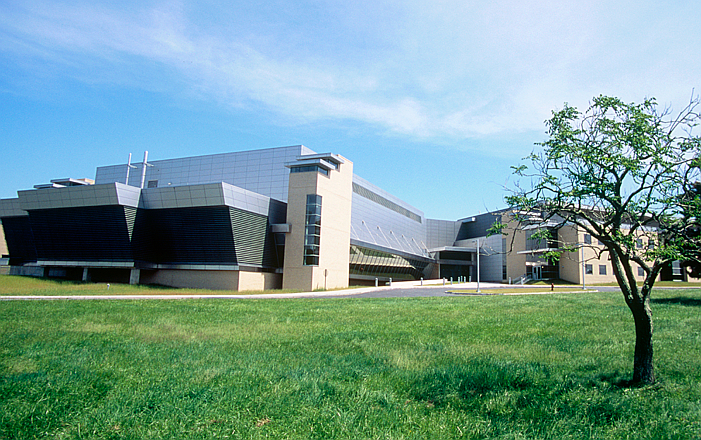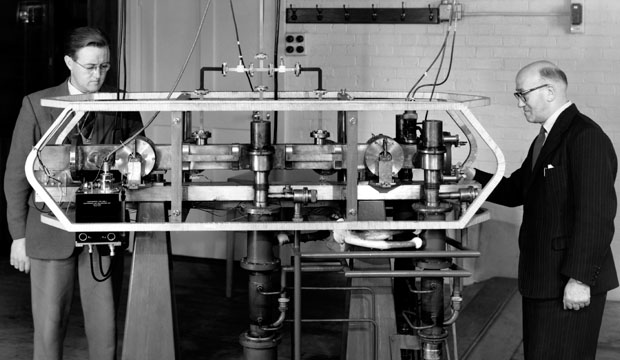|
Calibration
In measurement technology and metrology, calibration is the comparison of measurement values delivered by a device under test with those of a calibration standard of known accuracy. Such a standard could be another measurement device of known accuracy, a device generating the quantity to be measured such as a voltage, a sound tone, or a physical artifact, such as a meter ruler. The outcome of the comparison can result in one of the following: * no significant error being noted on the device under test * a significant error being noted but no adjustment made * an adjustment made to correct the error to an acceptable level Strictly speaking, the term "calibration" means just the act of comparison and does not include any subsequent adjustment. The calibration standard is normally traceable to a national or international standard held by a metrology body. BIPM Definition The formal definition of calibration by the International Bureau of Weights and Measures (BIPM) is the foll ... [...More Info...] [...Related Items...] OR: [Wikipedia] [Google] [Baidu] |
Metrology
Metrology is the scientific study of measurement. It establishes a common understanding of Unit of measurement, units, crucial in linking human activities. Modern metrology has its roots in the French Revolution's political motivation to standardise units in France when a length standard taken from a natural source was proposed. This led to the creation of the decimal-based metric system in 1795, establishing a set of standards for other types of measurements. Several other countries adopted the metric system between 1795 and 1875; to ensure conformity between the countries, the ''International Bureau of Weights and Measures, Bureau International des Poids et Mesures'' (BIPM) was established by the Metre Convention. This has evolved into the International System of Units (SI) as a result of a resolution at the 11th General Conference on Weights and Measures (CGPM) in 1960. Metrology is divided into three basic overlapping activities: * The definition of units of measurement * ... [...More Info...] [...Related Items...] OR: [Wikipedia] [Google] [Baidu] |
Light Meter
A light meter (or illuminometer) is a device used to measure the amount of light. In photography, an exposure meter is a light meter coupled to either a Digital data, digital or analog calculator which displays the correct shutter speed and f-number for optimum exposure (photography), exposure, given a certain lighting situation and film speed. Similarly, exposure meters are also used in the fields of cinematography and scenic design, in order to determine the optimum light level for a scene. Light meters also are used in the general field of architectural lighting design to verify proper installation and performance of a building lighting system, and in assessing the light levels for growing plants. If a light meter is giving its indications in luxes, it is called a "luxmeter". Evolution File:Watkins Bee Meter.jpg, Watkins Bee Meter - a type of actinometer File:Leudi extinction meter.jpg, Leudi extinction meter File:METROPHOT.jpg, Metrophot Norwood Director IMG2024062813453 ... [...More Info...] [...Related Items...] OR: [Wikipedia] [Google] [Baidu] |
ISO 17025
ISO/ IEC 17025 General requirements for the competence of testing and calibration laboratories is the main standard used by testing and calibration laboratories. In most countries, ISO/IEC 17025 is the standard for which most labs must hold accreditation in order to be deemed technically competent. In many cases, suppliers and regulatory authorities will not accept test or calibration results from a lab that is not accredited. Originally known as ISO/IEC Guide 25, ISO/IEC 17025 was initially issued by ISO/IEC in 1999. There are many commonalities with the ISO 9000 standard, but ISO/IEC 17025 is more specific in requirements for competence and applies directly to those organizations that produce testing and calibration results and is based on more technical principles. Laboratories use ISO/IEC 17025 to implement a quality system aimed at improving their ability to consistently produce valid results. Material in the standard also forms the basis for accreditation from an accreditati ... [...More Info...] [...Related Items...] OR: [Wikipedia] [Google] [Baidu] |
Measurement Uncertainty
In metrology, measurement uncertainty is the expression of the statistical dispersion of the values attributed to a quantity measured on an interval or ratio scale. All measurements are subject to uncertainty and a measurement result is complete only when it is accompanied by a statement of the associated uncertainty, such as the standard deviation. By international agreement, this uncertainty has a probabilistic basis and reflects incomplete knowledge of the quantity value. It is a non-negative parameter. The measurement uncertainty is often taken as the standard deviation of a state-of-knowledge probability distribution over the possible values that could be attributed to a measured quantity. Relative uncertainty is the measurement uncertainty relative to the magnitude of a particular single choice for the value for the measured quantity, when this choice is nonzero. This particular single choice is usually called the measured value, which may be optimal in some well-defined ... [...More Info...] [...Related Items...] OR: [Wikipedia] [Google] [Baidu] |
Noise Dosimeter
A noise dosimeter (American English) or noise dosemeter (British English) is a specialized sound level meter intended specifically to measure the noise exposure of a person integrated over a period of time. It is often used to comply with Health and Safety regulations such as the Occupational Safety and Health (OSHA) 29 CFR 1910.95 Occupational Noise Exposure Standard or EU Directive 2003/10/EC. Noise Measurement Noise dosimeters measure and store sound pressure levels (SPL) and, by integrating these measurements over time, provide a cumulative noise-exposure reading for a given period of time, such as an 8-hour workday. Dosimeters can function as personal or area noise monitors. In occupational settings, personal noise dosimeters are often worn on the body of a worker with the microphone mounted on the middle-top of the person's most exposed shoulder. Area monitoring can be used to estimate noise exposure when the noise levels are relatively constant and employees are not mo ... [...More Info...] [...Related Items...] OR: [Wikipedia] [Google] [Baidu] |
Standard (metrology)
In metrology (the science of measurement), a standard (or etalon) is an Realisation (metrology), object, system, or experiment that bears a defined relationship to a unit of measurement of a physical quantity. Standards are the fundamental reference for a system of weights and measures, against which all other measuring devices are compared. Historical standards for length, volume, and mass were defined by many different authorities, which resulted in confusion and inaccuracy of measurements. Modern measurements are defined in relationship to internationally standardized reference objects, which are used under carefully controlled laboratory conditions to define the units of length, mass, electrical potential, and other physical quantities. Hierarchy of standards There is a three-level hierarchy of physical measurement standards. At the top of the tree are the master standards – these are known as ''primary standards''. Primary standards are made to the highest metrological q ... [...More Info...] [...Related Items...] OR: [Wikipedia] [Google] [Baidu] |
National Institute Of Standards And Technology
The National Institute of Standards and Technology (NIST) is an agency of the United States Department of Commerce whose mission is to promote American innovation and industrial competitiveness. NIST's activities are organized into Outline of physical science, physical science laboratory programs that include Nanotechnology, nanoscale science and technology, engineering, information technology, neutron research, material measurement, and physical measurement. From 1901 to 1988, the agency was named the National Bureau of Standards. History Background The Articles of Confederation, ratified by the colonies in 1781, provided: The United States in Congress assembled shall also have the sole and exclusive right and power of regulating the alloy and value of coin struck by their own authority, or by that of the respective states—fixing the standards of weights and measures throughout the United States. Article 1, section 8, of the Constitution of the United States, ratified i ... [...More Info...] [...Related Items...] OR: [Wikipedia] [Google] [Baidu] |
NIST
The National Institute of Standards and Technology (NIST) is an agency of the United States Department of Commerce whose mission is to promote American innovation and industrial competitiveness. NIST's activities are organized into physical science laboratory programs that include nanoscale science and technology, engineering, information technology, neutron research, material measurement, and physical measurement. From 1901 to 1988, the agency was named the National Bureau of Standards. History Background The Articles of Confederation, ratified by the colonies in 1781, provided: The United States in Congress assembled shall also have the sole and exclusive right and power of regulating the alloy and value of coin struck by their own authority, or by that of the respective states—fixing the standards of weights and measures throughout the United States. Article 1, section 8, of the Constitution of the United States, ratified in 1789, granted these powers to the new Co ... [...More Info...] [...Related Items...] OR: [Wikipedia] [Google] [Baidu] |
National Physical Laboratory (United Kingdom)
The National Physical Laboratory (NPL) is the national measurement standards laboratory of the United Kingdom. It sets and maintains physical standards for British industry. Founded in 1900, the NPL is one of the oldest metrology institutes in the world. Research and development work at the laboratory has contributed to the advancement of many disciplines of science, including the development of early computers in the late 1940s and 1950s, construction of the first accurate atomic clock in 1955, and the invention and first implementation of packet switching in the 1960s, which is today one of the fundamental technologies of the Internet. The former heads of NPL include many individuals who were pillars of the British scientific establishment. NPL is based at Bushy Park in Teddington, southwest London. It is operated by NPL Management Ltd, a company owned by the Department for Science, Innovation and Technology, and is one of the most extensive government laboratories in the ... [...More Info...] [...Related Items...] OR: [Wikipedia] [Google] [Baidu] |
National Accreditation Board For Testing And Calibration Laboratories
National Accreditation Board for Testing and Calibration Laboratories (NABL) provides accreditation services to Conformity Assessment Bodies (Laboratories) in India. NABL Schemes include Accreditation (Recognition) of Technical competence of testing, calibration, medical testing laboratories, Proficiency testing providers (PTP), Reference Material Producers (RMP) and Biobanks for a specific scope following ISO/IEC 17025, ISO 15189, ISO/IEC 17043 & ISO 17034:2016, Biobank Standards. It has Mutual Recognition Arrangement (MRA) with Asia Pacific Accreditation Cooperation (APAC), International Laboratory Accreditation Cooperation (ILAC). NABL is a constituent board of Quality Council of India which is an autonomous body setup under Department for Promotion of Industry and Internal Trade (DPIIT), Ministry of Commerce and Industry, Government of India. NABL provides accreditation in all major fields of Science and Engineering such as Biological, Chemical, Electrical, Electronics ... [...More Info...] [...Related Items...] OR: [Wikipedia] [Google] [Baidu] |
National Physical Laboratory, UK
The National Physical Laboratory (NPL) is the national measurement standards laboratory of the United Kingdom. It sets and maintains physical standards for British industry. Founded in 1900, the NPL is one of the oldest metrology institutes in the world. Research and development work at the laboratory has contributed to the advancement of many disciplines of science, including the development of early computers in the late 1940s and 1950s, construction of the first accurate atomic clock in 1955, and the invention and first implementation of packet switching in the 1960s, which is today one of the fundamental technologies of the Internet. The former heads of NPL include many individuals who were pillars of the British scientific establishment. NPL is based at Bushy Park in Teddington, southwest London. It is operated by NPL Management Ltd, a company owned by the Department for Science, Innovation and Technology, and is one of the most extensive government laboratories in the ... [...More Info...] [...Related Items...] OR: [Wikipedia] [Google] [Baidu] |
Physikalisch-Technische Bundesanstalt
The Physikalisch-Technische Bundesanstalt (PTB) is the national metrology institute of the Federal Republic of Germany, with scientific and technical service tasks. It is a higher federal authority and a public-law institution directly under federal government control, without legal capacity, under the auspices of the Federal Ministry for Economic Affairs and Climate Action. Tasks Together with NIST in the USA and the National Physical Laboratory (United Kingdom), NPL in Great Britain, PTB ranks among the leading metrology institutes in the world. As the National Metrology Institute of Germany, PTB is Germany's highest and only authority in terms of correct and reliable measurements. The Units and Time Act Bundesgesetzblatt (Germany), Bundesgesetzblatt (Federal Law Gazette), volume 2008, part I, No. 28, p. 1185 ff., 11 July 2008] assigns all tasks which are related with the realization and dissemination of the units to PTB. All legally relevant aspects regarding the units ... [...More Info...] [...Related Items...] OR: [Wikipedia] [Google] [Baidu] |








